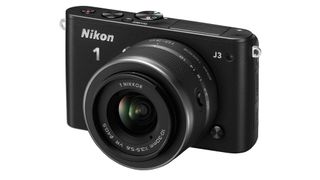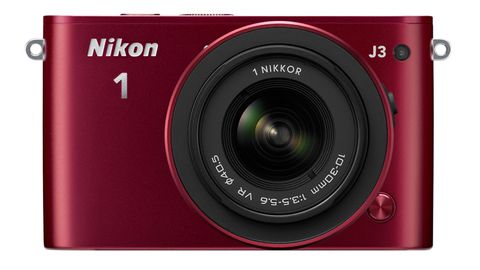TechRadar Verdict
Pros
- +
Good screen
- +
Smart Photo Selector
- +
Small size
Cons
- -
Small sensor
- -
No viewfinder
- -
Not a touchscreen
Why you can trust TechRadar
In a move which would make Panasonic proud, Nikon has already updated the J range of its compact system cameras, mere months after introducing the Nikon 1 J2. The company says that the Nikon 1 J3 is, for now, an addition to the range, but has admitted that it will reassess whether the J2 stays in the range pretty soon.
The J3 has the world's smallest body for a compact system camera, with a CX format (1-inch) sensor. Given that only Nikon produces those, that's perhaps not too difficult, but what the company also tells us is that it is smaller than all other CSCs, aside from the Pentax Q cameras, which use even smaller sensors.
While the Nikon 1 J2 had a 10 million pixel sensor, the Nikon 1 J3 has been upgraded to a 14 million pixel device. That gives the J2 the same pixel count as the Nikon 1 V2, the company's top of the range CSC. We're told it's the same device so we can expect to see very similar performance when we put the J3 through our lab tests.

Like the Nikon 1 J2 and V2, the J3 has Slow View mode, which enables you to see the action in slow motion to record the decisive moment, and Live Image Control, which gives you a preview of the effects of settings in the monitor prior to shooting.
In addition, the Snapshot function has been improved and there's an Advanced Movie mode that enables settings adjustments in Program, Shutter Priority, Aperture Priority and Manual Exposure mode when recording movies.
The Nikon 1 J3 has a sensitivity range of ISO 160-6400, and can capture up to approximately 22 shots with a single burst of continuous shooting at 15fps (with AF tracking), and approximately 20 shots with a single burst of continuous shooting at 60fps (without AF tracking).

Nikon claims that this is also its joint fastest CSC to date, with an Expeed 3A processing engine. This is the same engine as found in the Nikon V2 and enables processing speeds of up to 850 megapixels per second, facilitating the 60fps shooting mode.
As with the other cameras in the Nikon 1 series, the J3 features a hybrid autofocusing system. Switching between phase-detection AF and contrast-detection AF depending on the situation, this means that it can claim very fast focusing speeds, even in low light scenarios.
Like the J2 before it, the J3 has a 921k dot, 3-inch LCD monitor on the back of the camera for composing images. It's not a touchscreen, and it doesn't tilt or articulate, but a wide viewing angle is promised. There's no inbuilt electronic viewfinder, and there's also no possibility to add one since there's no hotshoe or accessories port.

The Nikon J1 was incredibly popular, being the biggest selling CSC in Europe and Japan in the 12 months after it was launched. Despite the smaller sensor size and restricted range of lenses when compared to other cameras from the likes of Panasonic and Olympus, Nikon has still managed to find a large audience.
As it stands, the company now has three lines in its CSC range. The J3 now occupies the mid-range space, since the Nikon 1 S1, an entry-level CSC, was also announced in the early part of 2013. The company suspects that the S1 will take the place of the J1 as its mass seller, with the J3 as a step-up, or more premium option, thanks to its additional resolution and higher quality build.
With a recommended retail price of £579/US$599.95 (around AU$874) including a 10-30mm kit lens, the Nikon 1 J3 goes head to head with the likes of the Panasonic G5, Olympus PEN Mini and Sony NEX-F3.

Amy has been writing about cameras, photography and associated tech since 2009. Amy was once part of the photography testing team for Future Publishing working across TechRadar, Digital Camera, PhotoPlus, N Photo and Photography Week. For her photography, she has won awards and has been exhibited. She often partakes in unusual projects - including one intense year where she used a different camera every single day. Amy is currently the Features Editor at Amateur Photographer magazine, and in her increasingly little spare time works across a number of high-profile publications including Wired, Stuff, Digital Camera World, Expert Reviews, and just a little off-tangent, PetsRadar.


